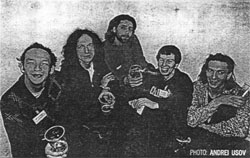Sweet Dreams and Parallel Realities
 In early March, the Petersburg group Ole Lukkoye recorded a track for the
psychedelic compilation album Eno Tribute, which will be released in the United States.
The album is dedicated to the music of Brian Eno and will contain cover versions of his
works by musicians from around the world. Ole Lukkoye was the only Russian group
invited to contribute to this prestigious project.
In early March, the Petersburg group Ole Lukkoye recorded a track for the
psychedelic compilation album Eno Tribute, which will be released in the United States.
The album is dedicated to the music of Brian Eno and will contain cover versions of his
works by musicians from around the world. Ole Lukkoye was the only Russian group
invited to contribute to this prestigious project.
When keyboardist Boris Bardash and bass guitarist Andrei Lavrinenko left the
progressive/art-rock outfit The Rainy Season in the spring of 1989, no one could have even
guessed that their new project would lead to this. The hard road they set out on has brought them
neither money nor nationwide fame and a track on the popular Soyuz compilation albums. The
recognition of their work by genuine music connoisseurs in different countries is worth more
than any pompous award, however.
Boris and Andrei dubbed themselves Ole Lukkoye, and in that very same year of 1989 they
took to the stage for the first time with appearances at the Leningrad Rock Club's seventh
festival and the Rock Aurora festival. It was' a time for experimenting: the band's lineup changed
often, each new musician adding something original to the group's sound. Even back then an
eastern bias was making itself audible, becoming stronger in 1991 with the arrival of bassoonist
Alexander Frolov.
Ole Lukkoye's first LP was the 1993 release Zapara. By that time the quest for their
own sound had led the musicians to psychedelic ethnotrance. Although, as is often the case with
bold experimental music, critics are at something of a loss when it comes to classifying Ole
Lukkoye's work. In contrast to “psychedelic ethnotrance,” a term chosen by the
Belgian psychedelic journal Crohinga Well one German critic described Ole Lukkoye as
“folklore from nowhere.” It has to be said that this is a fairly accurate description
of the feelings their music provokes in the listener. Unobtrusive eastern harmonies are
concealed, as it were, in a music that is trance-like to the point of shamanism. The musicians
stress that they take a highly creative approach to folk roots and try to find contemporary twists
on this foundation. As a result, it seems to the listener that a number of ethnic sources have been
used, an impression strengthened by the “imaginary” language in which many of
the songs are performed. According to Boris Bardash, the phonetics of this invented language is
ideally suited to the group's style, as English is to rock and roll, for example. “Ole
Lukkoye is about sweet dreams and parallel realities,” he says, adding that these kinds of
experiences cannot be described with ordinary words.
Visual accompaniment became a part of Ole Lukkoye concerts in 1996, first in the form of
projected video, with computer animation added later. And so music that was already vivid and
original acquired new shadings, and the band's concerts began to resemble rituals. Thanks to the
TaMtAm Club and Seva Gakkel, the musicians met a German producer who organized a concert
tour of Germany and later assisted them with the release of their album Tumze (Lollipop
Shop, 1996). The TaMtAm was also where they met Norwegian woman Marit Sande, who
arranged a Scandinavian tour. Last year the group contributed to the psychedelic compilation
album “Floralia II,” which gathered the best psychedelic tracks from all corners of
the globe.
An ordinary Ole Lukkoye song lasts 8-10 minutes. Maybe that's why their works aren't
played on the air so often and the rank-and-file radio listener isn't familiar with their music. This,
however, hasn't kept Ole Lukkoye from evolving to the delight of their fans.
Oleg YURCHENKO, “Na Dne”, #5(38), 1998
 In early March, the Petersburg group Ole Lukkoye recorded a track for the
psychedelic compilation album Eno Tribute, which will be released in the United States.
The album is dedicated to the music of Brian Eno and will contain cover versions of his
works by musicians from around the world. Ole Lukkoye was the only Russian group
invited to contribute to this prestigious project.
In early March, the Petersburg group Ole Lukkoye recorded a track for the
psychedelic compilation album Eno Tribute, which will be released in the United States.
The album is dedicated to the music of Brian Eno and will contain cover versions of his
works by musicians from around the world. Ole Lukkoye was the only Russian group
invited to contribute to this prestigious project.